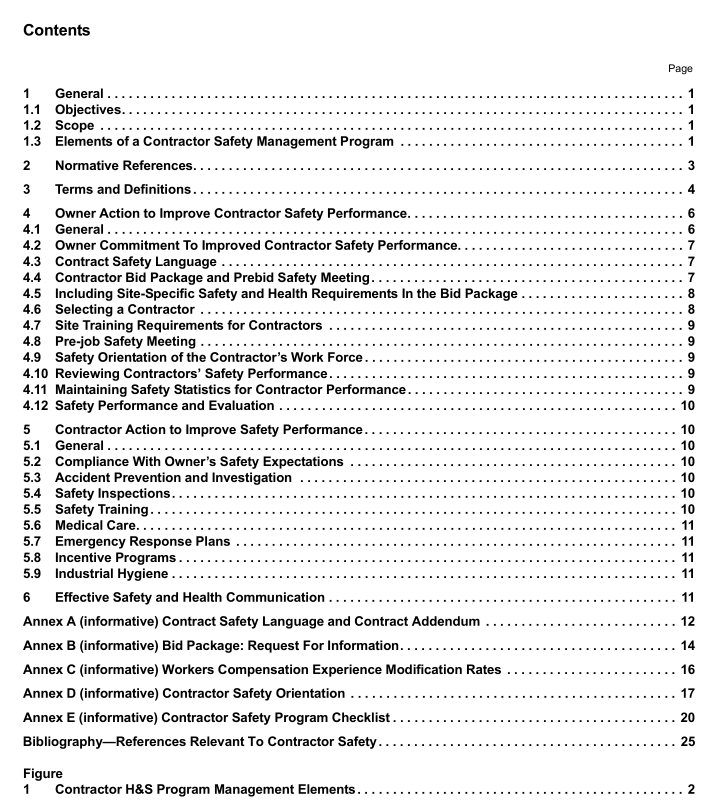API St 2220 pdf download

API St 2220 pdf download Contractor Safety Performance Process
4.2 Owner Commitment To Improved Contractor Safety Performance Common to all successful contractor safety programs are the owners’ commitment to, and continued support of, the programs. The owners’ commitment and support are essential in minimizing incidents and preventing injuries and illnesses. Effective contractor safety programs require the owners to focus resources on safety and to review how contractor safety is being addressed. To emphasize their commitment, many owners incorporate the need for contractor safety in senior management policy statements on health, safety and the environment.
4.3 Contract Safety Language Although “standard” safety language (e.g. “the contractor must comply with all federal, state, and local safety regulations”) should be included in a contract, additional safety language may be necessary to clearly convey the owner’s expectations. To minimize the need to modify the owner’s existing contract language, a specific safety addendum can be developed and attached to the contract when more detailed safety requirements must be addressed for a particular project or work activity. Annex A provides examples of contract safety language and a safety addendum.
4.4 Contractor Bid Package and Prebid Safety Meeting An owner can inform a contractor of its safety expectations by clearly outlining its safety performance requirements in its bid package. Such a prebid package should define the safety standards the contractor is expected to meet. Bid packages and subsequent safety meetings may not be practical for certain projects, such as short-term, non-process- related projects. The owner may require the contractor’s program to meet safety standards that are at least equal to the owner’s. The owner should request specific safety information from the contractor that can be used as part of the selection process, and for the proposal to be complete, it is critical that the contractor provide this information in a clear manner. (A prebid meeting may be useful to reinforce this point.) In addition, the contractor should be informed of the selection criteria and, where appropriate, that the lowest bid will not necessarily be selected. Annex B provides an example of the type of information that may be requested in a prebid package or during a prebid meeting.
4.5 Including Site-Specific Safety and Health Requirements In the Bid Package Safety procedures vary among companies and job sites and may have a significant impact on a contractor’s proposal and subsequent work. Therefore, even though the contract language and prebid package include the requirement to follow all rules and regulations, it is important that before the contract is awarded, each bidder be made aware of the specific job-site safety rules that will apply. Safety and health requirements for the contractor should be consistent with the requirements established by the owner for its employees, including industrial hygiene assessments of activities for chemical or physical exposures.
4.6 Selecting a Contractor The selection of a qualified contractor is a major step toward obtaining safe contractor performance. An owner can evaluate a contractor’s safety program by using the safety information furnished by the contractor in response to the prebid request. API 2221, Contractor and Owner Safety Program Implementation provides extensive guidance, tools and examples of approaches used for contractor selection. Additional information directed toward upstream oil activities appears in API 76, Contractor Safety Management for Oil and Gas Drilling and Production Operations.
The following points can indicate the quality of a contractor’s safety performance:
a) The contractor’s commitment to safety, as demonstrated by an ongoing safety program that is supported by its top management.
b) The completeness of the contractor’s safety programs and their appropriateness for the work site and the safety standards of the owner.
c) The contractor’s response to prebid PQF safety information requests (see Annex B), which may include the following.
1) Injury and illness incidence rates.
2) Experience modification rates, if applicable (see Annex C).
3) The contractor’s safety staffing plan. The plan describes the on-site person or persons appointed by the contractor and subcontractor who will be responsible for safety. It also describes their expertise and authority.
4) A description of the safety orientation program to be provided by the contractor to all contractor employees onsite.
5) The contractor’s enforcement and disciplinary action program regarding safety violations.
6) The contractor’s policy and programs regarding alcohol, controlled substances, and firearms.
7) A list of safety equipment that will be provided by the contractor.









